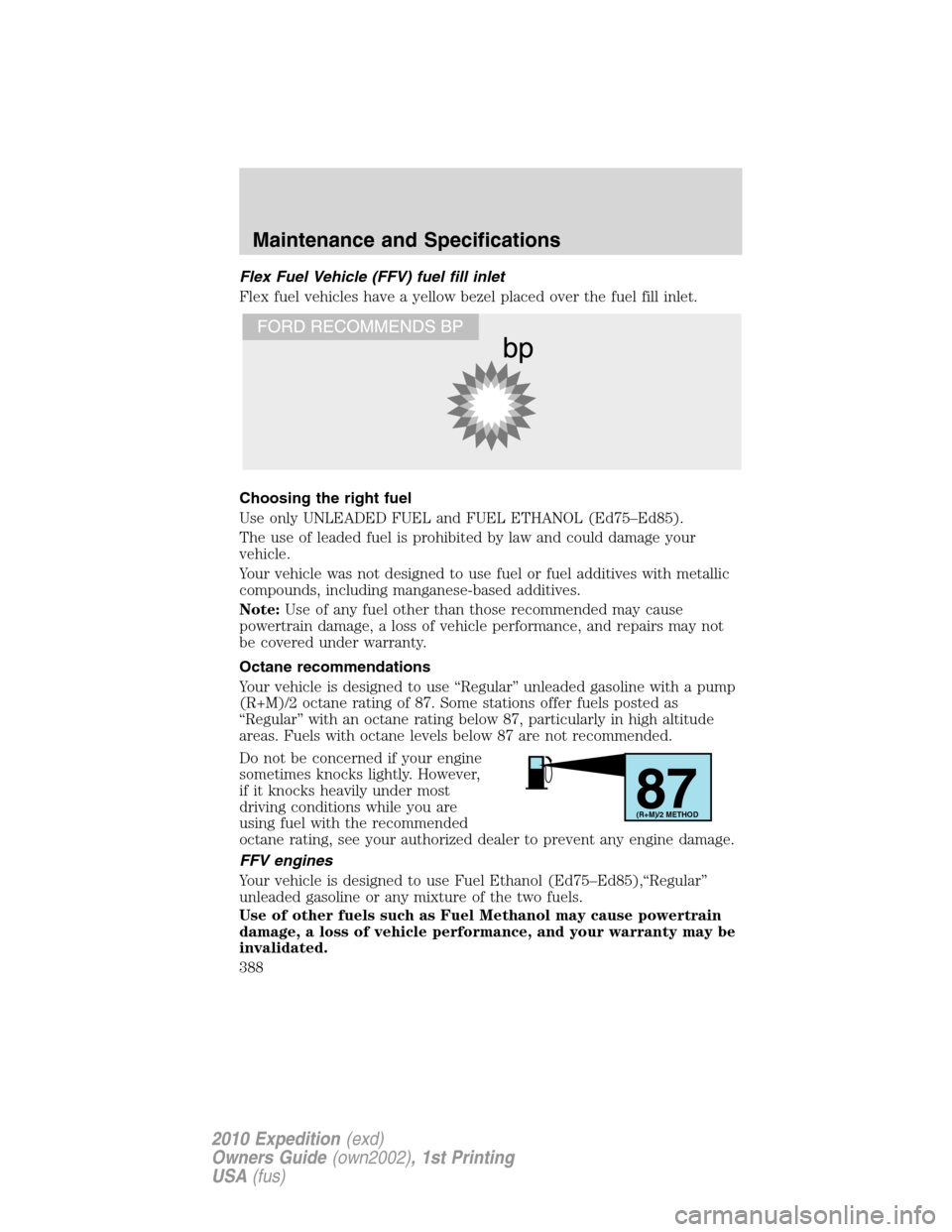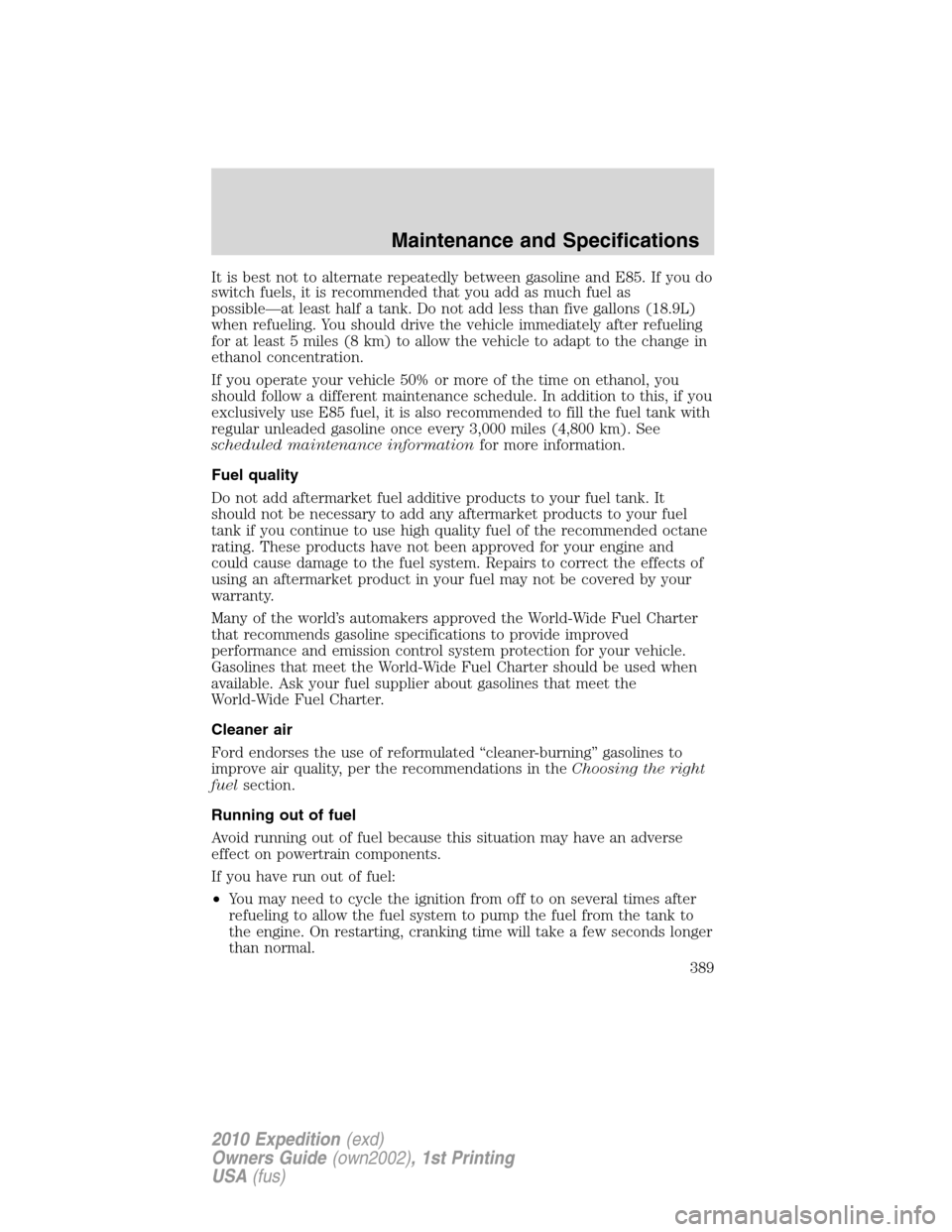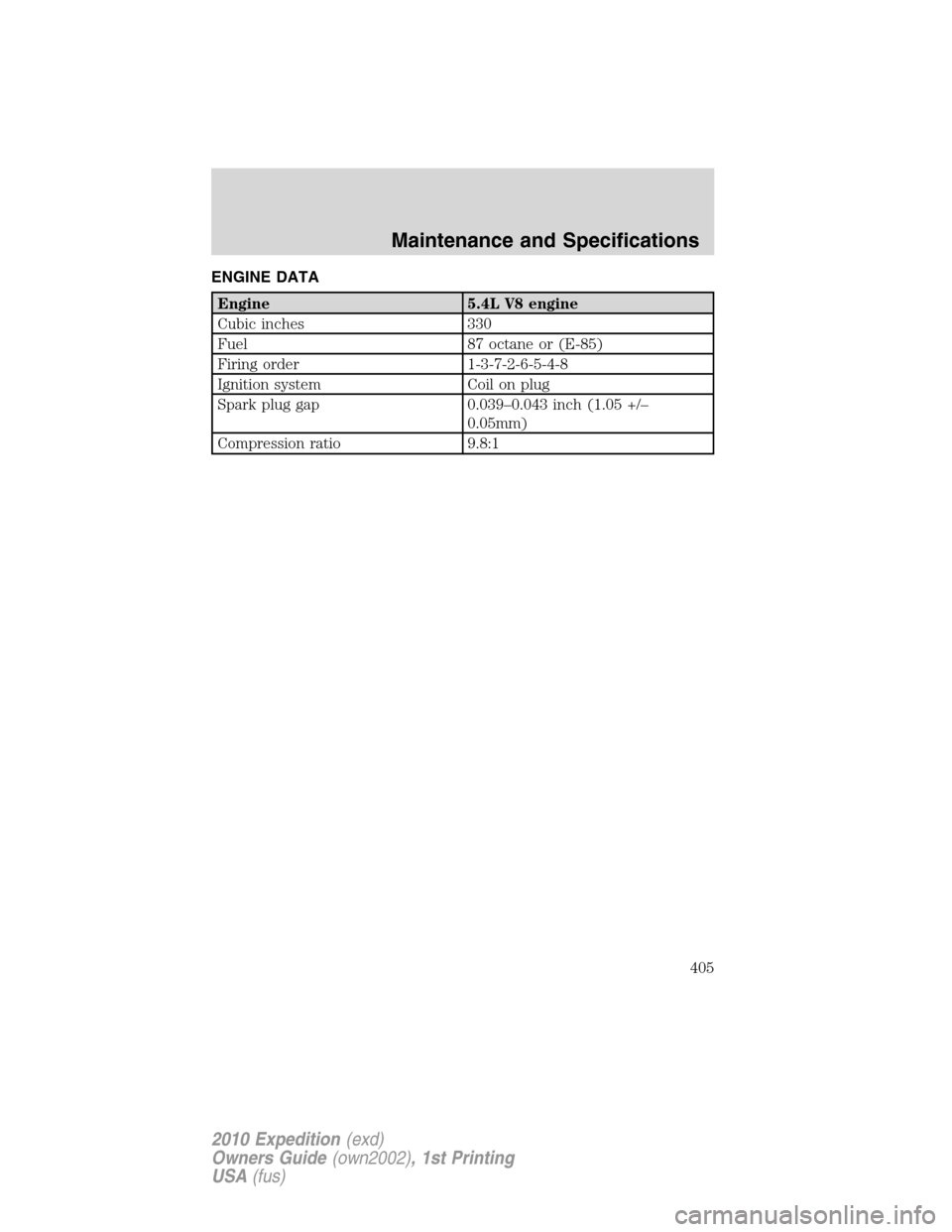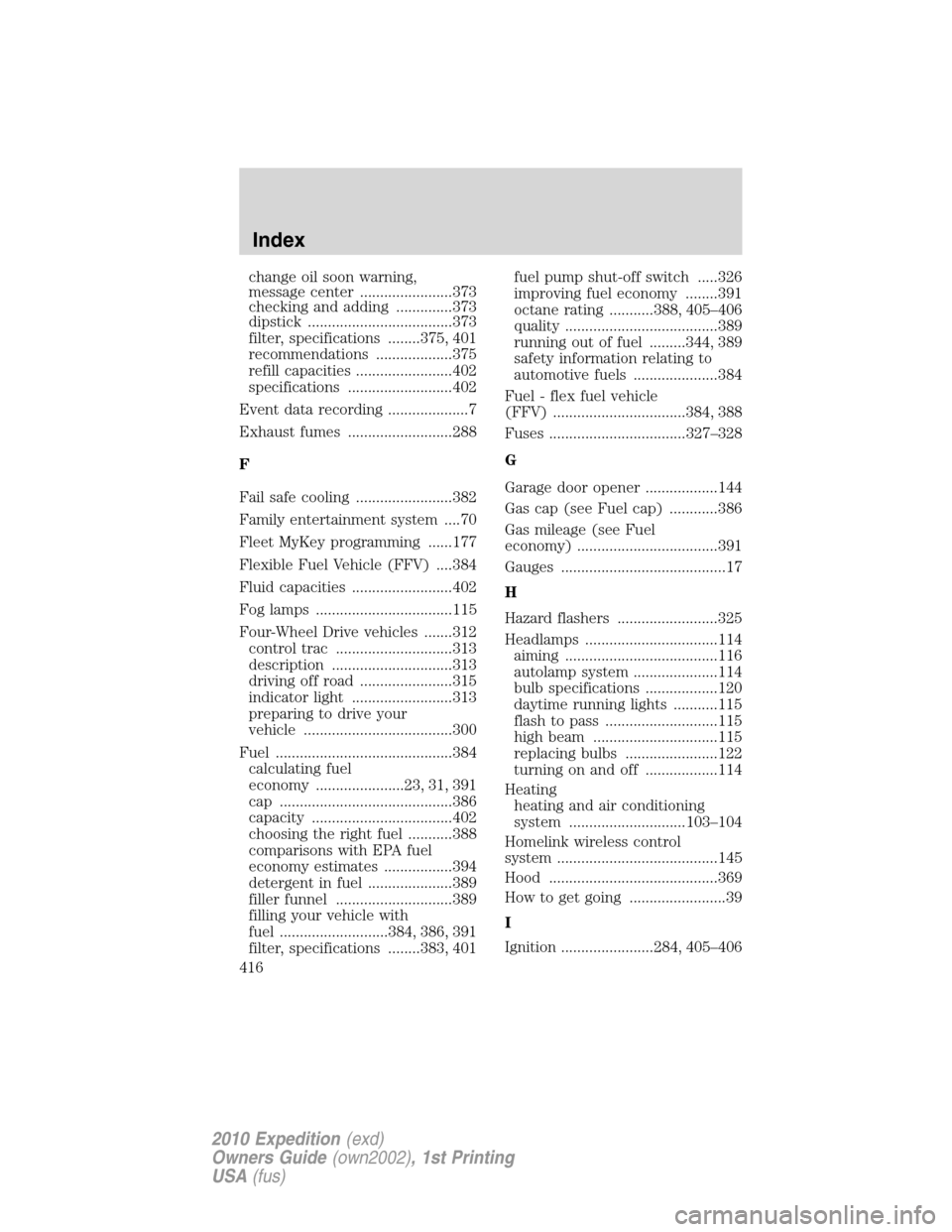2010 FORD EXPEDITION octane
[x] Cancel search: octanePage 385 of 420

•Fuels can also be harmful if absorbed through the skin. If fuel is
splashed on the skin and/or clothing, promptly remove contaminated
clothing and wash skin thoroughly with soap and water. Repeated or
prolonged skin contact with fuel liquid or vapor causes skin irritation.
•Be particularly careful if you are taking “Antabuse” or other forms of
disulfiram for the treatment of alcoholism. Breathing gasoline and/or
ethanol vapors, or skin contact could cause an adverse reaction. In
sensitive individuals, serious personal injury or sickness may result. If
fuel is splashed on the skin, promptly wash skin thoroughly with soap
and water. Consult a physician immediately if you experience an
adverse reaction.
•FFV fuel tanks may contain zero to 85 percent ethanol. Any fuel
blends containing gasoline and ethanol should be treated the same as
“Fuel Ethanol.” Flex fuel vehicles have a yellow bezel placed over the
fuel fill inlet.
Pure ethanol is the alcohol which is the intoxicating agent in liquor, beer
and wine. It is distilled from the fermentation of plants such as field corn
and sugar cane. When ethanol is produced for use in motor fuels, a small
amount of gasoline is added to make it unfit for beverage use. The
resulting ethanol blend is called denatured fuel ethanol meaning that it is
denatured with 2% to 5% gasoline and is suitable for automotive use.
During the summer season, fuel ethanol may contain a maximum of 85%
denatured ethanol (Ed85) and 15% unleaded gasoline. The fuel ethanol
has a higher octane rating than unleaded regular or premium gasoline
and this allows the design of engines with greater efficiency and power.
Winter blends may contain up to 75% denatured ethanol (Ed75) and up
to 25% unleaded gasoline to enhance cold engine starts. Severely cold
weather may require additional measures for reliable starting.
Ethanol is more chemically active than gasoline. It corrodes some metals
and causes some plastic and rubber components to swell, break down or
become brittle and crack, especially when mixed with gasoline. Special
materials and procedures have been developed for flexible fuel vehicles
and the dispensers used by ethanol fuel providers.
WARNING:Flexible fuel components and standard unleaded
gasoline fuel components are not interchangeable. If your vehicle
is not serviced in accordance with flexible fuel vehicles procedures,
damage may occur and your warranty may be invalidated.
Maintenance and Specifications
385
2010 Expedition(exd)
Owners Guide(own2002), 1st Printing
USA(fus)
Page 388 of 420

Flex Fuel Vehicle (FFV) fuel fill inlet
Flex fuel vehicles have a yellow bezel placed over the fuel fill inlet.
Choosing the right fuel
Use only UNLEADED FUEL and FUEL ETHANOL (Ed75–Ed85).
The use of leaded fuel is prohibited by law and could damage your
vehicle.
Your vehicle was not designed to use fuel or fuel additives with metallic
compounds, including manganese-based additives.
Note:Use of any fuel other than those recommended may cause
powertrain damage, a loss of vehicle performance, and repairs may not
be covered under warranty.
Octane recommendations
Your vehicle is designed to use “Regular” unleaded gasoline with a pump
(R+M)/2 octane rating of 87. Some stations offer fuels posted as
“Regular” with an octane rating below 87, particularly in high altitude
areas. Fuels with octane levels below 87 are not recommended.
Do not be concerned if your engine
sometimes knocks lightly. However,
if it knocks heavily under most
driving conditions while you are
using fuel with the recommended
octane rating, see your authorized dealer to prevent any engine damage.
FFV engines
Your vehicle is designed to use Fuel Ethanol (Ed75–Ed85),“Regular”
unleaded gasoline or any mixture of the two fuels.
Use of other fuels such as Fuel Methanol may cause powertrain
damage, a loss of vehicle performance, and your warranty may be
invalidated.
87(R+M)/2 METHOD
Maintenance and Specifications
388
2010 Expedition(exd)
Owners Guide(own2002), 1st Printing
USA(fus)
Page 389 of 420

It is best not to alternate repeatedly between gasoline and E85. If you do
switch fuels, it is recommended that you add as much fuel as
possible—at least half a tank. Do not add less than five gallons (18.9L)
when refueling. You should drive the vehicle immediately after refueling
for at least 5 miles (8 km) to allow the vehicle to adapt to the change in
ethanol concentration.
If you operate your vehicle 50% or more of the time on ethanol, you
should follow a different maintenance schedule. In addition to this, if you
exclusively use E85 fuel, it is also recommended to fill the fuel tank with
regular unleaded gasoline once every 3,000 miles (4,800 km). See
scheduled maintenance informationfor more information.
Fuel quality
Do not add aftermarket fuel additive products to your fuel tank. It
should not be necessary to add any aftermarket products to your fuel
tank if you continue to use high quality fuel of the recommended octane
rating. These products have not been approved for your engine and
could cause damage to the fuel system. Repairs to correct the effects of
using an aftermarket product in your fuel may not be covered by your
warranty.
Many of the world’s automakers approved the World-Wide Fuel Charter
that recommends gasoline specifications to provide improved
performance and emission control system protection for your vehicle.
Gasolines that meet the World-Wide Fuel Charter should be used when
available. Ask your fuel supplier about gasolines that meet the
World-Wide Fuel Charter.
Cleaner air
Ford endorses the use of reformulated “cleaner-burning” gasolines to
improve air quality, per the recommendations in theChoosing the right
fuelsection.
Running out of fuel
Avoid running out of fuel because this situation may have an adverse
effect on powertrain components.
If you have run out of fuel:
•You may need to cycle the ignition from off to on several times after
refueling to allow the fuel system to pump the fuel from the tank to
the engine. On restarting, cranking time will take a few seconds longer
than normal.
Maintenance and Specifications
389
2010 Expedition(exd)
Owners Guide(own2002), 1st Printing
USA(fus)
Page 391 of 420

ESSENTIALS OF GOOD FUEL ECONOMY
Measuring techniques
Your best source of information about actual fuel economy is you, the
driver. You must gather information as accurately and consistently as
possible. Fuel expense, frequency of fill-ups or fuel gauge readings are
NOT accurate as a measure of fuel economy. We do not recommend
taking fuel economy measurements during the first 1,000 miles
(1,600 km) of driving (engine break-in period). You will get a more
accurate measurement after 2,000 miles–3,000 miles (3,000 km–5,000
km).
Filling the tank
The advertised fuel capacity of the fuel tank on your vehicle is equal to
the rated refill capacity of the fuel tank as listed in theMaintenance
product specifications and capacitiessection of this chapter.
The advertised capacity is the amount of the indicated capacity and the
empty reserve combined. Indicated capacity is the difference in the
amount of fuel in a full tank and a tank when the fuel gauge indicates
empty. Empty reserve is the small amount of fuel remaining in the fuel
tank after the fuel gauge indicates empty.
The amount of usable fuel in the empty reserve varies and should
not be relied upon to increase driving range. When refueling your
vehicle after the fuel gauge indicates empty, you might not be
able to refuel the full amount of the advertised capacity of the
fuel tank due to the empty reserve still present in the tank.
For consistent results when filling the fuel tank:
•Turn the engine/ignition switch to the off position prior to refueling,
an error in the reading will result if the engine is left running.
•Use the same filling rate setting (low — medium — high) each time
the tank is filled.
•Allow no more than two automatic click-offs when filling.
•Always use fuel with the recommended octane rating.
•Use a known quality gasoline, preferably a national brand.
•Use the same side of the same pump and have the vehicle facing the
same direction each time you fill up.
•Have the vehicle loading and distribution the same every time.
Your results will be most accurate if your filling method is consistent.
Maintenance and Specifications
391
2010 Expedition(exd)
Owners Guide(own2002), 1st Printing
USA(fus)
Page 405 of 420

ENGINE DATA
Engine 5.4L V8 engine
Cubic inches 330
Fuel 87 octane or (E-85)
Firing order 1-3-7-2-6-5-4-8
Ignition system Coil on plug
Spark plug gap 0.039–0.043 inch (1.05 +/–
0.05mm)
Compression ratio 9.8:1
Maintenance and Specifications
405
2010 Expedition(exd)
Owners Guide(own2002), 1st Printing
USA(fus)
Page 416 of 420

change oil soon warning,
message center .......................373
checking and adding ..............373
dipstick ....................................373
filter, specifications ........375, 401
recommendations ...................375
refill capacities ........................402
specifications ..........................402
Event data recording ....................7
Exhaust fumes ..........................288
F
Fail safe cooling ........................382
Family entertainment system ....70
Fleet MyKey programming ......177
Flexible Fuel Vehicle (FFV) ....384
Fluid capacities .........................402
Fog lamps ..................................115
Four-Wheel Drive vehicles .......312
control trac .............................313
description ..............................313
driving off road .......................315
indicator light .........................313
preparing to drive your
vehicle .....................................300
Fuel ............................................384
calculating fuel
economy ......................23, 31, 391
cap ...........................................386
capacity ...................................402
choosing the right fuel ...........388
comparisons with EPA fuel
economy estimates .................394
detergent in fuel .....................389
filler funnel .............................389
filling your vehicle with
fuel ...........................384, 386, 391
filter, specifications ........383, 401fuel pump shut-off switch .....326
improving fuel economy ........391
octane rating ...........388, 405–406
quality ......................................389
running out of fuel .........344, 389
safety information relating to
automotive fuels .....................384
Fuel - flex fuel vehicle
(FFV) .................................384, 388
Fuses ..................................327–328
G
Garage door opener ..................144
Gas cap (see Fuel cap) ............386
Gas mileage (see Fuel
economy) ...................................391
Gauges .........................................17
H
Hazard flashers .........................325
Headlamps .................................114
aiming ......................................116
autolamp system .....................114
bulb specifications ..................120
daytime running lights ...........115
flash to pass ............................115
high beam ...............................115
replacing bulbs .......................122
turning on and off ..................114
Heating
heating and air conditioning
system .............................103–104
Homelink wireless control
system ........................................145
Hood ..........................................369
How to get going ........................39
I
Ignition .......................284, 405–406
Index
416
2010 Expedition(exd)
Owners Guide(own2002), 1st Printing
USA(fus)
Page 417 of 420

Illuminated visor mirror ...........128
Infant seats
(see Safety seats) .....................231
Inspection/maintenance (I/M)
testing ........................................396
Instrument panel
cleaning ...................................363
cluster ........................................12
lighting up panel and
interior .....................................116
J
Jack ............................................335
positioning ...............................335
storage .....................................335
Jump-starting your vehicle ......345
K
Keyless entry system
autolock ...................................162
keypad .....................................172
locking and unlocking doors ..173
programming entry code .......172
Keys ...................................161, 175
positions of the ignition .........284
L
Lamps
autolamp system .....................114
bulb replacement
specifications chart ................120
daytime running light .............115
fog lamps .................................115
headlamps ...............................114
headlamps, flash to pass ........115
instrument panel, dimming ...116
interior lamps .................118, 121
replacing bulbs ...............122, 124LATCH anchors .........................235
Liftgate ......................154, 158, 168
Lights, warning and indicator ....12
anti-lock brakes (ABS) ..........291
Limited-slip axle .......................300
Load limits .................................268
Loading instructions .................275
Locks
autolock ...................................162
childproof ................................166
doors ........................................162
Lubricant specifications ...........402
Lug nuts ....................................343
Lumbar support, seats .....187–188
M
Message center ...............20, 28–29
english/metric button .........25, 35
system check button ................35
warning messages ...............25, 35
Mirrors ...............................134–135
automatic dimming rearview
mirror ......................................134
fold away .................................135
heated ......................................136
programmable memory ..........169
signal .......................................136
Moon roof ..................................143
Motorcraft parts ................367, 401
MyKey ........................................177
N
Navigation system .....................102
O
Octane rating ............................388
Index
417
2010 Expedition(exd)
Owners Guide(own2002), 1st Printing
USA(fus)